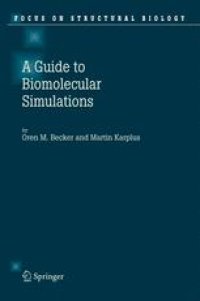
Ebook: A Guide to Biomolecular Simulations
- Tags: Computer Applications in Chemistry, Computer Appl. in Life Sciences, Biophysics/Biomedical Physics, Theoretical and Computational Chemistry
- Series: Focus on Structural Biology 4
- Year: 2006
- Publisher: Springer Netherlands
- Edition: 1
- Language: English
- pdf
Molecular dynamics simulations have become instrumental in replacing our view of proteins as relatively rigid structures with the realization that they were dynamic systems, whose internal motions play a functional role. Over the years, such simulations have become a central part of biophysics. Applications of molecular dynamics in biophysics range over many areas. They are used in the structure determination of macromolecules with x-ray and NMR data, the modelling of unknown structures from their sequence, the study of enzyme mechanisms, the estimation of ligand-binding free energies, the evaluation of the role of conformational change in protein function, and drug design for targets of known structures.
The widespread application of molecular dynamics and related methodologies suggests that it would be useful to have available an introductory self-contained course by which students with a relatively limited background in chemistry, biology and computer literacy, can learn the fundamentals of the field. This Guide to Biomolecular Simulations tries to fill this need. The Guide consists of six chapters which provide the fundamentals of the field and six chapters which introduce the reader to more specialized but important applications of the methodology.
Molecular dynamics simulations have become instrumental in replacing our view of proteins as relatively rigid structures with the realization that they were dynamic systems, whose internal motions play a functional role. Over the years, such simulations have become a central part of biophysics. Applications of molecular dynamics in biophysics range over many areas. They are used in the structure determination of macromolecules with x-ray and NMR data, the modelling of unknown structures from their sequence, the study of enzyme mechanisms, the estimation of ligand-binding free energies, the evaluation of the role of conformational change in protein function, and drug design for targets of known structures.
The widespread application of molecular dynamics and related methodologies suggests that it would be useful to have available an introductory self-contained course by which students with a relatively limited background in chemistry, biology and computer literacy, can learn the fundamentals of the field. This Guide to Biomolecular Simulations tries to fill this need. The Guide consists of six chapters which provide the fundamentals of the field and six chapters which introduce the reader to more specialized but important applications of the methodology.
Molecular dynamics simulations have become instrumental in replacing our view of proteins as relatively rigid structures with the realization that they were dynamic systems, whose internal motions play a functional role. Over the years, such simulations have become a central part of biophysics. Applications of molecular dynamics in biophysics range over many areas. They are used in the structure determination of macromolecules with x-ray and NMR data, the modelling of unknown structures from their sequence, the study of enzyme mechanisms, the estimation of ligand-binding free energies, the evaluation of the role of conformational change in protein function, and drug design for targets of known structures.
The widespread application of molecular dynamics and related methodologies suggests that it would be useful to have available an introductory self-contained course by which students with a relatively limited background in chemistry, biology and computer literacy, can learn the fundamentals of the field. This Guide to Biomolecular Simulations tries to fill this need. The Guide consists of six chapters which provide the fundamentals of the field and six chapters which introduce the reader to more specialized but important applications of the methodology.
Content:
Front Matter....Pages i-ix
Introduction: Note to the Student....Pages 1-2
Introduction: Note to the Instructor....Pages 3-3
Introduction: UNIX....Pages 4-9
Introduction: CHARMM Primer....Pages 10-17
Introduction: CHARMM Template Files....Pages 18-18
Molecular Visualization....Pages 19-33
Energy and Minimization....Pages 35-50
Minimization and Analysis....Pages 51-63
Conformational Analysis....Pages 65-74
Basic Molecular Dynamics in Vacuum and in Solution....Pages 75-99
Molecular Dynamics and Analysis....Pages 101-130
Ligand Dynamics in Myoglobin....Pages 131-154
Normal Mode Analysis....Pages 155-171
Free Energy Calculations....Pages 173-192
Minimum Energy Paths and Transition States....Pages 193-203
Multiple Copy Simultaneous Search....Pages 205-212
Hemoglobin Cooperativity: the T-R Transition....Pages 213-220
Back Matter....Pages 221-221
Molecular dynamics simulations have become instrumental in replacing our view of proteins as relatively rigid structures with the realization that they were dynamic systems, whose internal motions play a functional role. Over the years, such simulations have become a central part of biophysics. Applications of molecular dynamics in biophysics range over many areas. They are used in the structure determination of macromolecules with x-ray and NMR data, the modelling of unknown structures from their sequence, the study of enzyme mechanisms, the estimation of ligand-binding free energies, the evaluation of the role of conformational change in protein function, and drug design for targets of known structures.
The widespread application of molecular dynamics and related methodologies suggests that it would be useful to have available an introductory self-contained course by which students with a relatively limited background in chemistry, biology and computer literacy, can learn the fundamentals of the field. This Guide to Biomolecular Simulations tries to fill this need. The Guide consists of six chapters which provide the fundamentals of the field and six chapters which introduce the reader to more specialized but important applications of the methodology.
Content:
Front Matter....Pages i-ix
Introduction: Note to the Student....Pages 1-2
Introduction: Note to the Instructor....Pages 3-3
Introduction: UNIX....Pages 4-9
Introduction: CHARMM Primer....Pages 10-17
Introduction: CHARMM Template Files....Pages 18-18
Molecular Visualization....Pages 19-33
Energy and Minimization....Pages 35-50
Minimization and Analysis....Pages 51-63
Conformational Analysis....Pages 65-74
Basic Molecular Dynamics in Vacuum and in Solution....Pages 75-99
Molecular Dynamics and Analysis....Pages 101-130
Ligand Dynamics in Myoglobin....Pages 131-154
Normal Mode Analysis....Pages 155-171
Free Energy Calculations....Pages 173-192
Minimum Energy Paths and Transition States....Pages 193-203
Multiple Copy Simultaneous Search....Pages 205-212
Hemoglobin Cooperativity: the T-R Transition....Pages 213-220
Back Matter....Pages 221-221
....